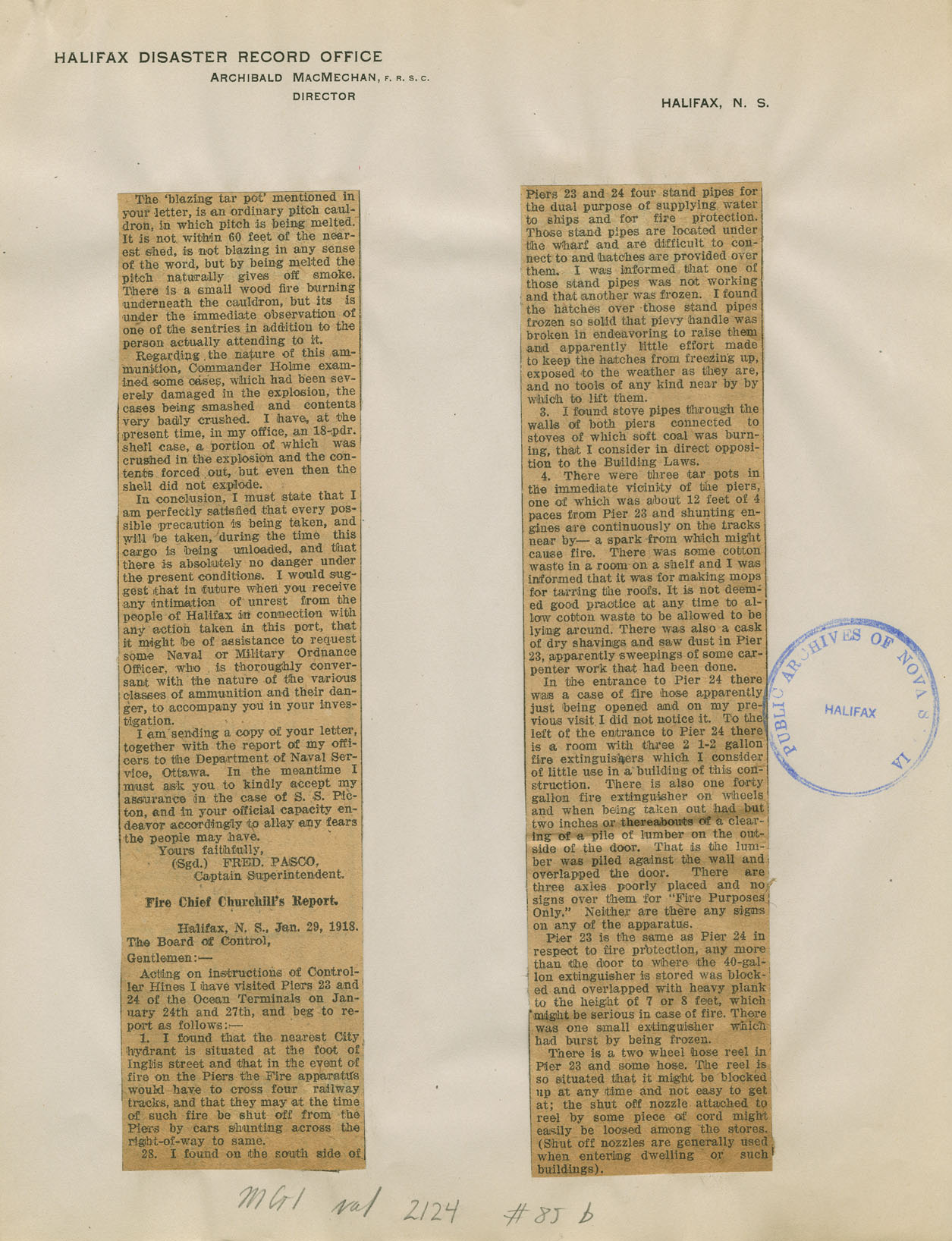Nova Scotia Archives
Archibald MacMechan
Halifax Disaster Record Office Materials
"Journal", clipping
30 January 1918. — 4 pages : 30 x 40 cm.
note: transcription publicly contributed - please contact us with comments, errors or omisions
Halifax Disaster Record Office
Archibald MacMechan, F.R.S.C.
Director
Halifax, N.S.
The "blazing tar pot" mentioned in your letter, is an ordinary pitch cauldron, in which pitch is being melted. It is not within 60 feet of the nearest shed, is not blazing in any sense of the word, but by being melted the pitch naturally gives off smoke. There is a small wood fire burning underneath the cauldron, but its is under the immediate observation of one of the sentries in addition to the person actually attending to it.
Regarding the nature of this ammunition, Commander Holme examined some cases, which had been severely damaged in the explosion, the cases being smashed and contents very badly crushed. I have, at the present time, in my office, an 18-pdr. shell case, a portion of which was crushed in the explosion and the contents forced out, but even then the shell did not explode.
In conclusion, I must state that I am perfectly satisfied that every possible precaution is being taken, and will be taken, during the time this cargo is being unloaded, and there is absolutely no danger under the present conditions. I would suggest that in the future when you receive any intimation of unrest from the people of Halifax in connection with any action taken in this port, that it might be of assistance to request some Naval or Military Ordinance Officer, who is thoroughly conversant with the nature of the various classes of ammunition and their danger, to accompany you in your investigation.
I am sending a copy of your letter, together with the report of my officers to the Department of Naval Service, Ottawa. In the meantime I must ask you to kindly accept my assurance in the case of S.S. Picton, and in your official capacity endeavor accordingly to allay any fears the people may have.
Yours faithfully,
(Sgd.) Fred Pasco,
Captain Superintendent.
Fire Chief Churchill's Report.
Halifax, N.S. Jan. 29, 1918.
The Board of Control,
Gentlemen: -
Acting on instructions of Controller Hines I have visited Piers 23 and 24 of the Ocean Terminals on January 24th and 27th, and beg to report as follows: -
1. I found the nearest City hydrant is situated at the foot of Inglis street and that in the event of fire on the Piers the Fire apparatus would have to cross four railway tracks, and that they may at the time of such fire be shut off from the Piers by cars shunting across the right-of-way to same.
2. I found on the south side of Piers 23 and 24 four stand pipes for the duel purpose of supplying water to ships and for fire protection. Those stand pipes are located under the wharf and difficult to connect to and hatches are provided over them. I was informed that one of those stand pipes was not working and that another was frozen. I found the hatches over those stand pipes frozen so solid that pievy handle was broken in endeavoring to raise them and apparently little effort made to keep the hatches from freezing up, exposed to the weather as they are, and no tools of any kind near by by which to lift them.
3. I found stove pipes through the walls of both piers connected to stoves of which soft coal was burning, that I consider in direct opposition to the Building Laws.
4. There were three tar pots in the immediate vicinity of the piers, one of which was about 12 feet of 4 paces from Pier 23 and shunting engines are continously on the tracks nearby - a spark from which might cause fire. There was some cotton waste in a room on a shelf and I was informed that it was for making mops for tarring the roofs. It is not deemed good practice at any time to allow cotton waste to be allowed to be lying around. There was also a cask of dry shavings and saw dust in Pier 23, apparently sweepings of some carpenter work that had been done.
In the entrance to Pier 24 there was a case of fire hose apparently just being opened and on my previous visit I did not notice it. To the left of the entrance to Pier 24 there is a room with three 2 1-2 gallon fire extinguishers which I consider of little use in a building of this construction. There is also one forty gallon fire extinguisher on wheels and when being taken out had but two inches or thereabouts of a clearing of a pile of lumber on the outside of the door. That is the lumber was piled against the wall and overlapped the door. There are three axles poorly placed and no signs over them for "Fire Purposes Only." Neither are there any signs on any of the apparatus.
Pier 23 is the same as Pier 24 in respect to fire protection, any more than the door to where the 40-gallon extinguisher is stored was blocked and overlapped with heavy plank to the height of 7 or 8 feet, which might be serious in case of fire. There was one small extinguisher which had burst by being frozen.
There is a two wheel hose reel in Pier 23 and some hose. The reel is so situated that it might be blocked up at any time and not easy to get at; the shut off nozzle attached to reel by some piece of cord might easily be loosed among the stores. (Shut off nozzles are generally used when entering dwelling or such buildings).
Reference: Archibald MacMechan Nova Scotia Archives MG 1 volume 2124 number 85

